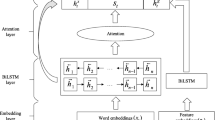Abstract
With the continuous development of cybersecurity texts, the importance of Chinese cybersecurity named entity recognition (NER) is increasing. However, Chinese cybersecurity texts contain not only a large number of professional security domain entities but also many English person and organization entities, as well as a large number of Chinese-English mixed entities. Chinese Cybersecurity NER is a domain-specific task, current models rarely focus on the cybersecurity domain and cannot extract these entities well. To tackle these issues, we propose a Multi-Task Learning framework based on Adversarial Training (MTLAT) to improve the performance of Chinese cybersecurity NER. Extensive experimental results show that our model, which does not use any external resources except static word embedding, outperforms state-of-the-art systems on the Chinese cybersecurity dataset. Moreover, our model outperforms the BiLSTM-CRF method on Weibo, Resume, and MSRA Chinese general NER datasets by 4.1%, 1.04%, 1.79% F1 scores, which proves the universality of our model in different domains.
Access this chapter
Tax calculation will be finalised at checkout
Purchases are for personal use only
Similar content being viewed by others
References
Aguilar, G., Maharjan, S., López-Monroy, A.P., Solorio, T.: A multi-task approach for named entity recognition in social media data. CoRR abs/1906.04135 (2019)
Dong, C., Zhang, J., Zong, C., Hattori, M., Di, H.: Character-based LSTM-CRF with radical-level features for Chinese named entity recognition. In: Lin, C.-Y., Xue, N., Zhao, D., Huang, X., Feng, Y. (eds.) ICCPOL/NLPCC -2016. LNCS (LNAI), vol. 10102, pp. 239–250. Springer, Cham (2016). https://doi.org/10.1007/978-3-319-50496-4_20
Goodfellow, I.J., Shlens, J., Szegedy, C.: Explaining and harnessing adversarial examples. In: ICLR (2015)
Huang, Z., Xu, W., Yu, K.: Bidirectional LSTM-CRF models for sequence tagging. CoRR abs/1508.01991 (2015)
Joshi, A., Lal, R., Finin, T., Joshi, A.: Extracting cybersecurity related linked data from text. In: 2013 IEEE Seventh International Conference on Semantic Computing, pp. 252–259. IEEE (2013)
Ju, Y., Zhao, F., Chen, S., Zheng, B., Yang, X., Liu, Y.: Technical report on conversational question answering. CoRR abs/1909.10772 (2019)
Lample, G., Ballesteros, M., Subramanian, S., Kawakami, K., Dyer, C.: Neural architectures for named entity recognition. In: NAACL, pp. 260–270 (2016)
Levow, G.A.: The third international Chinese language processing bakeoff: word segmentation and named entity recognition. In: ACL, pp. 108–117. Association for Computational Linguistics (2006)
Li, H., Hagiwara, M., Li, Q., Ji, H.: Comparison of the impact of word segmentation on name tagging for Chinese and Japanese. In: LREC, pp. 2532–2536 (2014)
Li, X., Meng, Y., Sun, X., Han, Q., Yuan, A., Li, J.: Is word segmentation necessary for deep learning of Chinese representations? In: ACL, pp. 3242–3252. Association for Computational Linguistics (2019)
Liu, Z., Winata, G.I., Fung, P.: Zero-resource cross-domain named entity recognition. In: ACL, pp. 1–6 (2020)
Lu, Y., Zhang, Y., Ji, D.: Multi-prototype Chinese character embedding. In: Proceedings of the Tenth International Conference on Language Resources and Evaluation (LREC 2016), pp. 855–859 (2016)
Madry, A., Makelov, A., Schmidt, L., Tsipras, D., Vladu, A.: Towards deep learning models resistant to adversarial attacks. In: ICLR (2018)
Miyato, T., Dai, A.M., Goodfellow, I.: Adversarial training methods for semi-supervised text classification. In: ICLR (2017)
Peng, N., Dredze, M.: Improving named entity recognition for Chinese social media with word segmentation representation learning. In: ACL: Short Papers (2016)
Qin, Y., Shen, G.W., Zhao, W.B., Chen, Y.P., Yu, M., Jin, X.: A network security entity recognition method based on feature template and CNN-BILSTM-CRF. Front. Inf. Technol. Electron. Eng. 20(6), 872–884 (2019)
Song, Y., Shi, S., Li, J., Zhang, H.: Directional skip-gram: explicitly distinguishing left and right context for word embeddings. In: NAACL-HLT, (Short Papers), vol. 2, pp. 175–180 (2018)
Weerawardhana, S., Mukherjee, S., Ray, I., Howe, A.: Automated extraction of vulnerability information for home computer security. In: Cuppens, F., Garcia-Alfaro, J., Zincir Heywood, N., Fong, P.W.L. (eds.) FPS 2014. LNCS, vol. 8930, pp. 356–366. Springer, Cham (2015). https://doi.org/10.1007/978-3-319-17040-4_24
Zhang, Y., Yang, J.: Chinese NER using lattice LSTM. In: ACL, pp. 1554–1564 (2018)
Zhao, S., Liu, T., Zhao, S., Wang, F.: A neural multi-task learning framework to jointly model medical named entity recognition and normalization. In: Proceedings of the AAAI Conference on Artificial Intelligence, vol. 33, pp. 817–824 (2019)
Zhu, C., Cheng, Y., Gan, Z., Sun, S., Goldstein, T., Liu, J.: FreeLB: enhanced adversarial training for language understanding. In: ICLR (2020)
Acknowledgments
This research is supported by National Key Research and Development Program of China (No.2019QY1303, No.2019QY1301, No.2018YFB0803602), and the Strategic Priority Research Program of the Chinese Academy of Sciences (No. XDC02040100), and National Natural Science Foundation of China (No. 61702508, No. 61802404). This work is also supported by the Program of Key Laboratory of Network Assessment Technology, the Chinese Academy of Sciences; Program of Beijing Key Laboratory of Network Security and Protection Technology.
Author information
Authors and Affiliations
Corresponding author
Editor information
Editors and Affiliations
Rights and permissions
Copyright information
© 2021 IFIP International Federation for Information Processing
About this paper
Cite this paper
Han, Y. et al. (2021). MTLAT: A Multi-Task Learning Framework Based on Adversarial Training for Chinese Cybersecurity NER. In: He, X., Shao, E., Tan, G. (eds) Network and Parallel Computing. NPC 2020. Lecture Notes in Computer Science(), vol 12639. Springer, Cham. https://doi.org/10.1007/978-3-030-79478-1_4
Download citation
DOI: https://doi.org/10.1007/978-3-030-79478-1_4
Published:
Publisher Name: Springer, Cham
Print ISBN: 978-3-030-79477-4
Online ISBN: 978-3-030-79478-1
eBook Packages: Computer ScienceComputer Science (R0)





